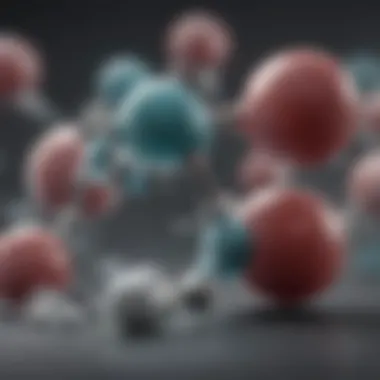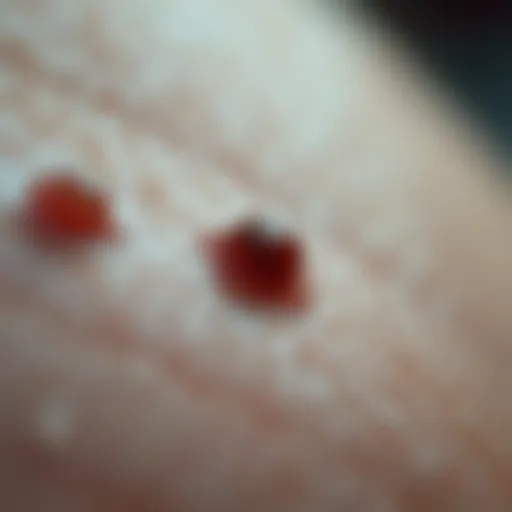Lysine and Cold Sores: A Comprehensive Guide


Intro
Lysine plays a significant role in health, particularly in the context of managing cold sores. Understanding how lysine interacts with the herpes simplex virus can direct effective treatment strategies. This article will explore the benefits of lysine, scientific evidence supporting its use, and practical applications in daily life. In an age when many seek natural alternatives to pharmaceutical solutions, lysine's role emerges as an interesting topic.
Key Benefits
Benefits for Physical Health
Lysine, an essential amino acid, is crucial for several bodily functions. One key benefit is its effectiveness in combating the herpes simplex virus, the primary cause of cold sores. Research suggests that lysine inhibits the replication of this virus. Studies show that a higher dietary intake of lysine correlates with fewer outbreaks in those prone to cold sores.
Some of the top sources of lysine include:
- Meats: Beef, pork, and chicken are rich in lysine.
- Fish: Seafood, especially cod and sardines, provides significant amounts.
- Dairy Products: Milk, cheese, and yogurt are excellent sources.
- Legumes: Beans and lentils also contain lysine, making them a good option for vegetarians.
It is essential to monitor lysine intake as part of diet planning. For those susceptible to cold sores, the addition of lysine supplements may prove beneficial.
Benefits for Mental Well-being
While most discussions around lysine focus on its physical benefits, its role in mental health and well-being is also noted. Stress is a known trigger for cold sore outbreaks. Some studies suggest that adequate lysine levels may help reduce anxiety and improve overall mood. Maintaining proper amino acid balances can be essential for mental clarity and emotional stability.
Practical Tips
Effective Meal Planning
To leverage the benefits of lysine, it is useful to plan meals with lysine-rich foods. Keeping a balanced diet helps maintain adequate levels of this amino acid. Consider integrating the following into your weekly diet:
- Grilled chicken breast with quinoa and vegetables
- Fish tacos with a side of black beans
- Lentil soup enriched with cheese
Portioning these meals properly can help avoid excessive calorie intake while ensuring that necessary nutrients, including lysine, are present.
Quick and Efficient Workouts
Physical activity also has its role in managing stress, which can, in turn, impact cold sore occurrences. Short, regular workouts contribute to overall well-being. Simple exercises like brisk walking, stretching, or yoga can be integrated into daily routines—even on a busy schedule. Targeting 30 minutes a day can lead to positive outcomes and further aid in the body's recovery processes.
Efforts to increase lysine through diet, alongside maintaining an active lifestyle, may provide significant assistance in managing cold sore outbreaks.
In summary, lysine is not just an amino acid; it represents a functional component of dietary strategy and lifestyle modification. The relationship between lysine and the herpes simplex virus underscores its relevance for those looking to manage cold sores naturally.
Prologue to Cold Sores
Cold sores, often referred to as fever blisters, are small, painful lesions that typically appear on or around the lips. They are caused primarily by the herpes simplex virus type 1 (HSV-1) but can also be linked to herpes simplex virus type 2 (HSV-2), commonly associated with genital herpes. Understanding cold sores is crucial for both patients and health care professionals alike, as they can affect a significant portion of the population. The implications of these lesions go beyond mere discomfort; they can impact social interactions, psychological well-being, and overall quality of life. Knowledge about their triggers, symptoms, and treatment options is essential for effective management.
Understanding Cold Sores
Cold sores usually start with a tingling, itching, or burning sensation at the site where the blister will form. This symptom can last from a few hours to a couple of days before a blister appears. The blister itself is filled with clear fluid and can break open, crusting over in a week or so. While the physical discomfort is bothersome, many individuals are also affected by the stigma associated with cold sores, leading to feelings of embarrassment and insecurity.
The recurrent nature of cold sores adds to the adversity faced by those who suffer from them. While some people experience infrequent outbreaks, others may have multiple occurrences in a year, often triggered by factors such as stress, hormonal changes, fatigue, or sun exposure. Gaining a deeper understanding of these triggers can empower individuals to minimize exposure and prevent outbreaks, fostering better management strategies.
The Herpes Simplex Virus
The herpes simplex virus is one of the most common viruses affecting humans. After the initial infection, the virus resides in nerve cells and remains dormant. Periodically, under certain triggers, it reactivates, leading to the formation of cold sores. It is essential to recognize that while the virus is contagious, many individuals may carry it without ever experiencing visible symptoms.
Transmission primarily occurs through skin-to-skin contact. This can happen even when no sores are visible, showcasing the hidden nature of the virus. Understanding the mechanisms of transmission and the lifecycle of the herpes simplex virus is critical for health professionals as they seek to educate patients about preventive measures. Awareness and education are key in curbing further spread of the virus. By examining the characteristics and behavior of the herpes simplex virus, one can better appreciate both the challenges and the therapeutic possibilities in managing cold sores.
Lysine Overview
Lysine is an essential amino acid that plays a substantial role in various biological functions within the human body. Understanding its properties can aid in managing health conditions like cold sores caused by the herpes simplex virus. This section will discuss what lysine is and the key biological functions it performs.
What is Lysine?


Lysine, scientifically known as L-lysine, is one of the nine essential amino acids. Unlike non-essential amino acids, which the body can synthesize, lysine must be obtained through diet. It is particularly crucial for protein synthesis, hormone production, and the absorption of calcium. Due to its vital role in these metabolic processes, lysine is of interest in the context of viral infections, especially cold sores.
Food sources rich in lysine include meat, fish, dairy products, legumes, and certain nuts and seeds. Yet, many individuals might not get enough of this amino acid, especially those with dietary restrictions. This deficiency can potentially affect immune function, making the body more susceptible to infections.
The Biological Function of Lysine
Lysine serves multiple important functions in the body:
- Protein Synthesis: As a building block of all proteins, lysine is necessary for the production of enzymes and hormones.
- Calcium Absorption: It plays a significant role in calcium metabolism, which is essential for bone health.
- Immune Function: Lysine has been linked to enhanced immune response, crucial for protecting against pathogens.
- Collagen Formation: It contributes to collagen production, which is essential for skin integrity and healing.
- Hormone Regulation: This amino acid also plays a part in regulating hormones, impacting various bodily functions.
"Lysine is crucial for protein synthesis and has a notable influence on immune function, making it relevant in managing cold sores."
Understanding these functions elucidates why lysine may be beneficial for individuals prone to cold sores. By doing so, this prepares the ground for further discussions about its mechanism of action against the herpes simplex virus and its effectiveness as a treatment option.
Mechanism of Action
Understanding the mechanism of action of lysine in the context of cold sore management is essential for health professionals, wellness coaches, and other practitioners. This section aims to clarify how lysine interacts with the herpes simplex virus (HSV) and elucidates its potential benefits in the treatment and prevention of cold sores.
Lysine is a vital amino acid that plays a critical role in various biochemical processes in the body. It is particularly significant in its relationship with arginine, another amino acid that the herpes simplex virus utilizes for its replication. The ratio of lysine to arginine in the body can influence viral activity, making this relationship a focal point in understanding lysine's effectiveness against HSV.
How Lysine Inhibits the Herpes Simplex Virus
Lysine inhibits the herpes simplex virus primarily by competing with arginine. The herpes virus needs arginine for its replication. When lysine levels are sufficiently high, they may effectively block arginine's access. This competition can theoretically limit the virus's ability to replicate, thereby reducing the severity or frequency of cold sore outbreaks.
Several studies have indicated that increasing dietary lysine intake or using lysine supplements can lower the recurrence of cold sores. Some of these investigations have reported significant reductions in the number of outbreaks, which grouped supports the hypothesis that lysine affects viral replication.
"Increased lysine is associated with fewer cold sore outbreaks, which provides a tangible dietary strategy for those prone to infections."
Role of Lysine in Viral Replication
To gain a complete understanding of lysine's role, it is crucial to examine how it contributes to the broader biological context of viral replication. The herpes simplex virus follows a specific life cycle that requires the host's resources. Lysine can intervene in this process by affecting the availability of arginine at critical points, which is imperative for viral synthesis and cell entry.
The implications of this interference can lead to:
- A decrease in viral load during outbreaks.
- Shortened recovery time for affected individuals.
- A potential reduction in transmission risk.
In summary, lysine's action against cold sores is not merely through direct inhibition but also by modifying the underlying biochemical milieu that supports the herpes simplex virus's replication. This knowledge equips health professionals with a deeper understanding of nutritional strategies to manage cold sores effectively.
Effectiveness of Lysine for Cold Sores
The effectiveness of lysine in managing cold sores is a critically important topic within this article. Cold sores, often caused by the herpes simplex virus, can be uncomfortable and persistent. Understanding how lysine functions and its potential benefits provides valuable insights for those looking to mitigate these outbreaks.
Lysine, as an essential amino acid, plays a role in numerous bodily functions, including immune support. Its relevance in combating the herpes simplex virus stems from its ability to inhibit the replication of this virus. Many individuals seek alternatives to conventional antiviral medications, making it imperative to explore lysine's efficacy in treating cold sores.
Research surrounding lysine highlights its promising properties when utilized alongside other treatment methods. This section will delve into studies that specifically address lysine's impact on cold sore outbreaks and its synergistic nature when combined with traditional treatments.
Research Studies on Lysine and Cold Sores
Numerous studies have investigated the role of lysine in the context of cold sores. One of the more notable studies by J. A. V. Chichhya and colleagues in the Journal of the International Society of Sports Nutrition demonstrated a clear correlation between increased lysine intake and reduced frequency of outbreaks. The study focused on participants who took lysine supplements and noted a significant decrease in the occurrence of cold sores compared to those who did not. This evidence suggests that lysine supplementation could serve as a viable method for managing herpes simplex outbreaks.
Additionally, another study highlighted in the American Journal of Clinical Nutrition observed a similar trend. It indicated that participants who maintained a high lysine to arginine ratio in their diet experienced fewer cold sore episodes. Inhibiting arginine, an amino acid that encourages viral replication, while promoting lysine intake may be key in preventing outbreaks.
Comparative Effectiveness with Other Treatments
When comparing lysine to other traditional treatments for cold sores, it remains crucial to recognize that lysine is not a replacement for antiviral medications but rather a complementary approach. Antiviral drugs such as acyclovir are widely used and exhibit potent effects in reducing the severity and duration of cold sore outbreaks. While lysine may not be as powerful as these medications, its advantages lie in fewer side effects and its availability in dietary sources.
- Lysine vs. Acyclovir: Acyclovir has demonstrated a profound ability to target the herpes virus directly. In contrast, lysine functions more as a preventative measure, fostering a less favorable environment for the virus.
- Safety Profile: Lysine is generally considered safe for most individuals, with minimal side effects reported. This contrasts with some antiviral medications that can cause gastrointestinal issues or allergic reactions in sensitive individuals.
Recommended Dosage
Understanding the recommended dosage of lysine is crucial for effectively managing cold sores. Amino acids like lysine need to be taken in proper amounts to ensure their efficacy and safety. Dosage can vary based on individual factors such as age, health status, and specific treatment goals. Too little may not provide the desired benefits, while excessive intake can lead to potential side effects.


Optimal Daily Intake of Lysine
The typical daily intake of lysine may depend on the individual's dietary habits and specific needs. For most adults, a general recommendation suggests 1000 to 3000 mg per day during outbreaks of cold sores. It is important to note that this amount is not advisable for everyone, and individuals should consult with a health professional for personalized guidance.
In cases of prevention, a lower dose of around 500 mg per day might be sufficient. In addition, athletes or individuals with higher protein needs might require more lysine, emphasizing the necessity of tailored dosages.
Lysine Supplementation vs. Dietary Sources
Lysine can be obtained from supplements or through dietary sources. Supplements offer a concentrated dose and may be useful for those with increased needs, especially when managing outbreaks. Common forms include capsules, powders, and tablets. However, dietary sources should not be overlooked.
Foods rich in lysine include:
- Meat and poultry: Chicken, turkey, lamb, and beef are excellent sources.
- Dairy products: Cheese, yogurt, and milk contain significant amounts of lysine.
- Fish: Tuna and salmon also provide beneficial lysine levels.
- Legumes: Beans and lentils can be good plant-based sources.
- Nuts and seeds: Though lower in lysine, certain nuts still contribute to intake.
When comparing supplementation to dietary sources, the body's absorption rate is possibly better with natural food sources. Furthermore, consuming whole foods provides other essential nutrients that enhance overall health. Therefore, a balanced approach that combines both supplementation and dietary intake may yield the best results in managing cold sores effectively.
Dietary Sources of Lysine
Understanding the dietary sources of lysine is vital since this amino acid plays a significant role in the management of cold sores. Lysine cannot be produced by the body, necessitating its intake from external sources, particularly foods. By ensuring adequate lysine intake, individuals can support their overall health and potentially enhance their defenses against the herpes simplex virus. This section discusses both animal-based and plant-based lysine sources, detailing their benefits and considerations.
Animal-Based Sources
Animal-based foods are by far the richest sources of lysine. Foods like meat, dairy products, and certain seafood offer high amounts of this essential amino acid. To illustrate:
- Red Meat: Beef and lamb are particularly high in lysine. A three-ounce serving of beef can provide around 3 grams of lysine.
- Poultry: Chicken and turkey are more lean sources that are also lysine-rich. A similar serving size will deliver approximately 2.5 grams of lysine.
- Fish: Specific types of fish, such as cod and sardines, contain high levels of lysine. A serving of sardines can add about 2 grams to one's lysine intake.
- Dairy Products: Milk, yogurt, and cheese provide ample lysine. A cup of milk can contribute roughly 0.9 grams, while hard cheeses increase this number significantly.
Including these foods in one's diet can be a direct way to meet the essential amino acid needs. However, it is crucial to be aware of the potential downsides to some animal products, such as higher levels of saturated fat or cholesterol.
Plant-Based Sources
While animal products dominate in lysine content, there are several plant-based foods that can also provide substantial amounts of this amino acid. This can be particularly significant for vegans or those who prefer a plant-based diet. Some notable sources include:
- Legumes: Beans, lentils, and peas are excellent vegetarian sources of lysine. For instance, a cup of cooked lentils can supply close to 1.3 grams of lysine.
- Quinoa: This grain-like seed is unique because it is a complete protein, thus containing all essential amino acids, including lysine. One cup offers about 0.4 grams of lysine.
- Nuts and Seeds: While they are not as high in lysine as animal products, almonds and pumpkin seeds provide moderate amounts. A quarter cup of pumpkin seeds can yield 0.6 grams.
- Soy Products: Foods like tofu and tempeh are rich in lysine, making them excellent options for vegetarians and vegans. A half-cup of tofu can contain around 1 gram of lysine.
Using a combination of both animal and plant-based sources is advisable for attaining a well-balanced lysine intake. Each food brings its own unique benefits, contributing to overall health and potentially aiding in managing cold sores.
Potential Side Effects of Lysine
Understanding the potential side effects of lysine is crucial for anyone considering its use for managing cold sores. While lysine is generally regarded as safe for most individuals, it is important to be aware of possible adverse reactions and contraindications. This section will outline common side effects associated with lysine supplementation, as well as key precautions that should be considered before starting any new regimen.
Common Side Effects
Lysine is an essential amino acid that does not usually lead to significant side effects when taken at recommended dosages. However, some individuals may experience:
- Gastrointestinal discomfort: Nausea, diarrhea, or stomach cramps can occur, especially if large doses are consumed. These reactions are generally mild and resolve on their own.
- Allergic reactions: Though rare, some people may exhibit allergic responses to lysine, such as rash, itching, or swelling. Anyone experiencing these symptoms should discontinue use immediately and seek medical advice.
- Interactions with other medications: Lysine could potentially interact with certain medications, altering their effectiveness or causing unexpected side effects.
Monitoring how your body reacts when taking lysine is advisable. Any unusual symptoms should be brought to medical professionals’ attention.
Precautions and Contraindications
Before incorporating lysine into your routine, certain precautions should be observed:
- Consult with a healthcare provider: This is especially important if you have existing health conditions or are taking other medications. A physician can assess any potential risks.
- Pregnancy and breastfeeding: The effects of lysine on pregnant or breastfeeding women have not been thoroughly studied. Caution should be exercised, and medical advice is recommended.
- Kidney issues: People with kidney disease may need to avoid lysine supplements since high protein intake can exacerbate their condition.
"Always prioritize a consultation with a health professional when considering new supplements, especially if you have pre-existing health concerns."
It is crucial to approach lysine supplementation with a comprehensive mindset. While it shows promise in managing cold sores, understanding its side effects and interactions helps ensure its safe and effective use. Always practice caution and be informed.
Synergistic Effects with Conventional Treatments
The relationship between lysine and traditional antiviral treatments offers significant insights for managing cold sores effectively. Understanding this synergy can inform both health professionals and patients about how to enhance treatment outcomes. Recognizing the interactions can lead to a more comprehensive approach in dealing with the herpes simplex virus.


Combining Lysine with Antiviral Medications
When considering the management of cold sores, lysine can play a pivotal role alongside antiviral medications like acyclovir or valacyclovir. These medications primarily aim to reduce the replication of the virus. When lysine is introduced into the treatment regimen, its mechanisms may complement the antiviral effects.
Research suggests that lysine may inhibit the uptake of arginine, an amino acid that the herpes virus needs to replicate. By limiting the availability of arginine, lysine could potentially enhance the effectiveness of antiviral drugs. This combined approach might result in reduced frequency and severity of outbreaks.
Combining lysine with antiviral medications could create a more robust framework for managing herpes virus symptoms effectively.
Care should be taken, however, when integrating these treatments. Consultation with healthcare providers is essential to establish the appropriate lysine dosage and monitor any possible interactions or side effects. Individual responses can vary, thus necessitating a tailored strategy based on patient conditions.
Complementary Lifestyle Adjustments
In addition to pharmacological treatments, lifestyle adjustments can greatly affect how individuals manage cold sores. Adding lysine-rich foods into one’s diet as well as avoiding triggers can be beneficial. Factors such as stress, sunlight exposure, and dietary habits can impact the frequency of outbreaks.
Consider the following adjustments:
- Dietary Choices: Include foods high in lysine, such as dairy products, fish, poultry, and legumes, while reducing arginine-rich foods like nuts and chocolate.
- Stress Management: Engaging in regular stress reduction practices like yoga, meditation, or deep-breathing exercises can help in managing outbreaks.
- Sun Protection: Apply sunscreen to the lips and face to prevent sun-induced triggers.
These lifestyle adjustments, when combined with lysine supplementation and conventional treatments, could form a holistic strategy for preventing cold sores. The idea is to create an environment where the virus is less likely to reactivate.
Ultimately, balancing systematic approaches through medications, nutrients, and healthy habits can optimize treatment outcomes.
Emerging Research and Trends
Understanding the latest developments surrounding lysine in the context of managing cold sores is imperative. Ongoing research explores the scope of lysine’s potential against viral infections, particularly those caused by the herpes simplex virus. As health professionals and nutritionists seek increasingly effective remedies, staying informed about emerging research is vital. This segment will examine recent studies focusing on lysine with attention to its implications for treatment, unraveling the intricacies tied to this essential amino acid.
Current Studies on Lysine and Viral Infections
Current studies have investigated the connection between lysine and various viral infections. Research indicates that lysine may play a role in inhibiting the growth and severity of herpes simplex virus infections. For example, an analysis published in The Journal of Infectious Diseases evaluated the effects of lysine on virus replication in vitro. Researchers found that higher lysine levels correlated with a reduction in viral replication rates. This finding suggests that increasing lysine intake could diminish the frequency or intensity of cold sore outbreaks.
Additionally, some studies aim to pinpoint the mechanisms behind lysine’s antiviral effects. For instance, a 2021 study in Antiviral Research pinpointed lysine's ability to interfere with arginine pathways, which the herpes virus relies on. If lysine can effectively block these crucial metabolic processes, it may provide a strategic advantage in preventing outbreaks.
"The emerging evidence points to lysine not just as a supplement but as a possible ally in the battle against viral infections like herpes."
The recent research underscores that lysine supplementation might be a valuable asset in treatment plans, particularly in the context of nutritional deficiencies. Further understanding lysine’s role can lead to optimized therapeutic strategies that incorporate dietary sources and supplementation.
Future Directions for Research
As promising as the existing research is, numerous avenues remain unexplored. Future studies should consider multidisciplinary approaches, integrating biochemistry, nutrition, and virology. One direction could involve long-term clinical trials assessing the effects of lysine supplementation in populations with recurrent cold sores. Understanding how different dosages and formulations impact outcomes can inform best practices for individuals affected by this condition.
Another essential area for future research is the potential interaction between lysine and other antiviral medications. Investigating how lysine might enhance or modify the effects of conventional therapies could yield significant insights for integrative treatment approaches. Researchers may also explore formulations that combine lysine with other supportive nutrients, creating comprehensive protocols aimed at managing herpes simplex virus symptoms.
Continued investigation into the safety and efficacy of lysine is crucial, particularly in diverse populations. As emerging trends unfold, understanding lysine’s role will equip healthcare providers with more extensive tools for effective interventions against cold sores and other viral infections. This progress reflects a broader commitment to not only alleviate symptoms but also enhance patients' quality of life.
Epilogue
In the exploration of lysine's role in managing cold sores, it is essential to recognize its potential as a valuable therapeutic tool. This article highlights the multifaceted nature of lysine, an essential amino acid, and its effectiveness against the herpes simplex virus. The specific elements discussed include the scientific mechanisms behind lysine's action, optimal dosages, and dietary sources.
Understanding these factors presents a comprehensive view of how lysine can serve not just as a standalone treatment but also as a complementary strategy to conventional antiviral therapies. By integrating lysine into a treatment regimen, individuals may experience reduced frequency and severity of cold sore outbreaks.
Additionally, considering the potential side effects and ensuring proper dosage is crucial. The importance of well-rounded knowledge cannot be overstated to empower health professionals, wellness coaches, nutritionists, fitness trainers, and mindfulness instructors.
Summary of Findings
Throughout this article, several core findings emerge:
- Lysine's Effectiveness: Research indicates that lysine can inhibit the replication of the herpes simplex virus, making it a valuable addition to treatment plans.
- Recommended Dosages: Optimal daily intake varies among individuals, but most studies suggest a range of 1,000 to 3,000 mg is beneficial during outbreaks and as a preventive measure.
- Dietary Sources: Significant lysine sources include meat, fish, dairy, and certain legumes and nuts, making it accessible for those seeking to enhance their intake naturally.
- Complementary Approaches: Combining lysine with antiviral medications can create a synergistic effect, amplifying therapeutic benefits while minimizing reliance on pharmaceuticals.
By synthesizing these findings, readers gain insight into how to effectively incorporate lysine into their health strategies for managing cold sores.
Final Thoughts on Lysine for Cold Sores
As we conclude, it is evident that lysine holds promise in the landscape of cold sore management. For health professionals and related fields, recognizing the nuanced role of this amino acid is crucial. It serves not only as a nutritional supplement but also as part of a holistic approach to treating viral infections. The alignment of evidence-based findings with practical guidance allows for informed decision-making.
Furthermore, ongoing research will surely shed more light on this topic, potentially expanding recommendations and treatments. As practitioners delve deeper into supporting patients, it is beneficial to keep abreast of emerging studies, which may yield novel insights regarding lysine and its efficacy against herpes simplex virus and other related viral infections.
Incorporating lysine into everyday health practices may empower individuals and enhance their overall quality of life while managing cold sores.















